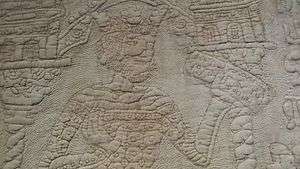Mark of Cornwall

Mark of Cornwall (Latin Marcus, Cornish Margh, Welsh March, Breton Marc'h) was a king of Kernow (Cornwall) in the early 6th century. He is most famous for his appearance in Arthurian legend as the uncle of Tristan and husband of Iseult, who engage in a secret affair.

The legend
Mark sent Tristan as his proxy to fetch his young bride, the Princess Iseult, from Ireland. Tristan and Iseult fall in love, and, with the help of a magic potion, proceed to have one of the stormiest love affairs in medieval literature. Mark suspects the affair and eventually his suspicions are confirmed. In some versions, he sends for Tristan to be hanged, and banishes Iseult to a leper colony. Tristan escapes the hanging and rescues Mark's bride from her confinement, later to be discovered by Mark. Mark eventually forgives them, with Iseult returning to Mark and Tristan leaving the country.
The story is cyclical with Mark suspecting Tristan and Iseult of adultery and then believing they were innocent. This happened again and again in the story. In the Beroul version, Tristan and Iseult are never in grave danger due to the narrator's declaration that he himself and God were on their side. King Mark, in the role of husband, is not portrayed as idealistic as other kings in Arthurian literature who were only portrayed in the role of king and not the personal role of husband.
In the Prose Tristan, Mark's character deteriorates from a sympathetic cuckold to a downright villain. He rapes his niece and then murders her when she produces his son, Meraugis. He murders his brother Baldwin as well. In earlier versions of the story, Tristan dies in Brittany, far away from Mark; but in the Prose Tristan, Mark stabs Tristan while he plays the harp under a tree for Iseult. Though this version of Mark's character was popular in other medieval works, including the Romance of Palamedes and Sir Thomas Malory's Le Morte d'Arthur, modern versions of the Tristan and Iseult legend tend to take their inspiration from the older poetic material, and Mark becomes a sympathetic character once again. In these legends, Mark is usually seen as ruling Cornwall from Tintagel Castle.
Mark has become associated with a Celtic variant of the story of Midas and his donkey ears from Greek mythology. In a Welsh tale, Mark has the ears of a horse – a pun on his name, March, Welsh for "horse".[1] There is a Breton legend in which he is also the king of Cornouaille, where, one day, he hunted a doe before discovering she was, actually, the princess Dahut who, for it, and under her human appearance, condemn him to have the ears and the mane of his horse Morvarc'h.
The Drustanus Stone
Known as The Tristan Stone, or The Longstone (Cornish: Menhir, meaning long stone), is a 2.7 m tall granite pillar near Fowey, Cornwall, originally situated at Castle Dore, near Fowey. The stone has a mid 6th century AD two line inscription which has been interpreted as reading DRVSTANVS HIC IACIT CVNOWORI FILIV'S ('Drustan lies here, of Cunomorus the son'). A now missing third line was described by the 16th century antiquarian John Leland as reading CVM DOMINA OUSILLA ('with the lady Ousilla'). Ousilla is a Latinisation of the Cornish female name Eselt, otherwise known as Isolde. The disappearance of this third line may be as a result of the stone being moved several times.[2]
In Wrmonoc of Landévennec's Life of St. Pol de Leon, he refers to a "King Marc whose other name is Quonomorus". Also rendered Cunomorus, this name means literally the 'Hound-of-the-sea.'[3] An inscription on a 6th-century gravestone near the Cornish town of Fowey memorializes (in Latin) a certain "Drustanus son of Cunomorus" and it has been conjectured that this is the "Tristan son of Mark (alias 'Quonomorus')" of legend. There is a monument believed by some to refer to Tristan ("Drustanus") at grid reference SX112521.
However, in most versions of the story, Mark is Tristan's uncle. His sister is Tristan's mother, Blancheflor alias Elizabeth/Isabelle, or, in some later versions, he is related to Tristan's father, Meliadus. Some identify King Mark with King Conomor of Dumnonia. However, it is also thought that Wrmonoc may have made a mistake with his recorded alias. In Old Welsh records, Mark is recorded as "March son of Meirchion" and is variously associated with North Wales, South Wales or South-West Scotland. The stone led to Mark's association with Castle Dore.
In music, film and television
Mark (called "Marke") is a character in Wagner's 1859 opera Tristan und Isolde, a role to be sung by a bass.
In the 1970s TV show Arthur of the Britons, Mark was played by Brian Blessed, and in the 2006 film Tristan & Isolde, he was played by Rufus Sewell. In "Lovespell" (1981) he was played by Richard Burton (as King Mark of Cornwall).
See also
![]() Media related to King Mark of Cornwall at Wikimedia Commons
Media related to King Mark of Cornwall at Wikimedia Commons
References
- ↑ Rhys, John (1901). Celtic Folklore: Welsh and Manx 1. Oxford: Oxford University Press. pp. 233–234.
- ↑ Craig Weatherhill, Cornovia: Ancient sites of Cornwall and Scilly 4000 BC – 1000 AD
- ↑ Thomas, Charles (1986) Celtic Britain. London: Thames & Hudson ISBN 0-500-02107-4; p. 70
| Legendary titles | ||
|---|---|---|
| Preceded by Felix |
King of Cornwall | Unknown |